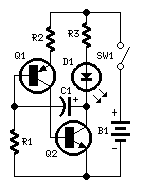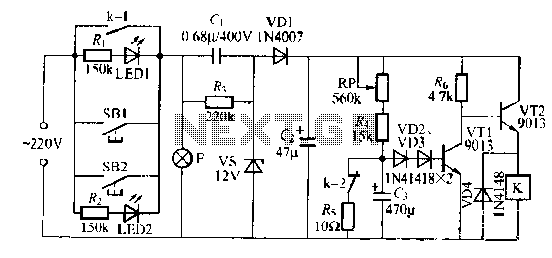
Bedside Lamp Timers

The objective of this circuit is to power a lamp or other device for a predetermined duration (30 minutes in this instance) and subsequently turn it off. This functionality is particularly beneficial for reading in bed at night, as it allows the bedside lamp to be automatically switched off if the reader falls asleep. Upon activation by the P1 pushbutton, an LED illuminates for approximately 25 minutes. Six minutes prior to the turn-off, the LED begins to blink for two minutes, then ceases blinking for another two minutes, and finally blinks again for two minutes, thus indicating that the on-time is nearing its end. If the user wishes to extend the reading time, an additional half-hour of light can be obtained by pressing the P1 button again. The lamp can be turned off at the user's discretion by pressing the P2 button. Transistors Q1 and Q2 form an ALL-ON ALL-OFF circuit that, when in the off state, draws negligible current. The P1 button initiates the circuit, activating the relay and powering the two integrated circuits (ICs). The lamp is controlled by the relay switch, while IC2 is reset with a positive voltage at pin 12. IC2 begins oscillating at a frequency determined by resistors R4 and capacitor C4. With the specified values, pin 3 goes high after approximately 30 minutes, turning off the circuit through capacitor C3. During the six minutes leading up to the turn-off, the LED blinks through connections of IC1 to pins 1, 2, and 15 of IC2. The blinking frequency is generated by the oscillator in IC2 at pin 9. The two gates of IC1 are connected in parallel to supply a higher current. If desired, a piezo sounder can be connected to pins 1 and 14 of IC1. Altering the brand of IC2 can change the oscillation frequency; for instance, Motorola's ICs tend to operate at a faster rate. Additionally, the timing can be modified by adjusting the values of C4 and R4.
This circuit design employs a relay to control the power to a lamp, making it suitable for applications where automatic shut-off is desired. The pushbutton P1 serves as the primary control for initiating the timing sequence, while P2 provides a manual override to turn off the lamp at any time. The use of two integrated circuits (ICs) facilitates the timing and blinking functionality. IC2 is responsible for generating the timing sequence through an internal oscillator, which is set to oscillate at a frequency determined by the external resistor and capacitor values. The output from IC2 pin 3 serves as the control signal for the relay, effectively toggling the power to the lamp.
The blinking LED serves as a visual indicator of the remaining time, providing the user with feedback that the lamp will soon turn off. The unique blinking pattern is designed to alert the user without being overly distracting, making it ideal for a nighttime reading environment. The design also allows for the integration of a piezo sounder, which can provide an audible alert in addition to the visual indicator, enhancing user awareness as the time limit approaches.
The circuit is designed to minimize power consumption when the lamp is off, as the ALL-ON ALL-OFF configuration ensures that the system draws minimal current in its idle state. This feature is particularly important for battery-operated devices, as it extends the operational lifespan between charges or replacements. The flexibility in timing adjustments through the modification of R4 and C4 allows for customization according to user preferences or specific application requirements. Overall, this circuit represents a practical solution for automating lamp control in a bedside reading scenario.The purpose of this circuit is that of power a lamp or other apparatus for a given time (30 minutes in this case), and then to turn it off. It`s useful when reading at bed by night, turning off the bedside lamp automatically in case the reader falls asleep.
After turn-on by P1 pushbutton, an LED lights for c25 minutes, but 6 minutes before the tur n-off, start blinking for two minutes, then stop blinking for other two minutes and finally blinks for other two minutes, thus signaling that the on-time is ending. If the user want to prolong the reading, can earn another half-hour of light by pushing on P1. Turning-off the lamp at user`s ease is obtained pushing on P2. Q1 and Q2 forms an ALL-ON ALL-OFF circuit that in the off state draw no significant current. P1 starts the circuit, the relay is turned on and the two ICs are powered. The lamp is powered by the relay switch, and IC2 is reset with a positive voltage at pin 12. IC2 start oscillating at a frequency settled by R4 and C4. With the values shown pin 3 goes high after c30 minutes, turning off the circuit via C3. During the c6 minutes preceding turn-off, the LED does a blinking action by connections of IC1 to pins 1, 2 & 15 of IC2.
Blinking frequency is provided by IC2 oscillator at pin 9. The two gates of IC1 are in parallel to source an higher current. If needed, a piezo sounder can be connected at pins 1 & 14 of IC1. Changing IC2 brand name, varies the oscillation frequency. In particular Motorola`s ICs run faster. Obviously, time can be varied changing C4 and R4 values. 🔗 External reference
This circuit design employs a relay to control the power to a lamp, making it suitable for applications where automatic shut-off is desired. The pushbutton P1 serves as the primary control for initiating the timing sequence, while P2 provides a manual override to turn off the lamp at any time. The use of two integrated circuits (ICs) facilitates the timing and blinking functionality. IC2 is responsible for generating the timing sequence through an internal oscillator, which is set to oscillate at a frequency determined by the external resistor and capacitor values. The output from IC2 pin 3 serves as the control signal for the relay, effectively toggling the power to the lamp.
The blinking LED serves as a visual indicator of the remaining time, providing the user with feedback that the lamp will soon turn off. The unique blinking pattern is designed to alert the user without being overly distracting, making it ideal for a nighttime reading environment. The design also allows for the integration of a piezo sounder, which can provide an audible alert in addition to the visual indicator, enhancing user awareness as the time limit approaches.
The circuit is designed to minimize power consumption when the lamp is off, as the ALL-ON ALL-OFF configuration ensures that the system draws minimal current in its idle state. This feature is particularly important for battery-operated devices, as it extends the operational lifespan between charges or replacements. The flexibility in timing adjustments through the modification of R4 and C4 allows for customization according to user preferences or specific application requirements. Overall, this circuit represents a practical solution for automating lamp control in a bedside reading scenario.The purpose of this circuit is that of power a lamp or other apparatus for a given time (30 minutes in this case), and then to turn it off. It`s useful when reading at bed by night, turning off the bedside lamp automatically in case the reader falls asleep.
After turn-on by P1 pushbutton, an LED lights for c25 minutes, but 6 minutes before the tur n-off, start blinking for two minutes, then stop blinking for other two minutes and finally blinks for other two minutes, thus signaling that the on-time is ending. If the user want to prolong the reading, can earn another half-hour of light by pushing on P1. Turning-off the lamp at user`s ease is obtained pushing on P2. Q1 and Q2 forms an ALL-ON ALL-OFF circuit that in the off state draw no significant current. P1 starts the circuit, the relay is turned on and the two ICs are powered. The lamp is powered by the relay switch, and IC2 is reset with a positive voltage at pin 12. IC2 start oscillating at a frequency settled by R4 and C4. With the values shown pin 3 goes high after c30 minutes, turning off the circuit via C3. During the c6 minutes preceding turn-off, the LED does a blinking action by connections of IC1 to pins 1, 2 & 15 of IC2.
Blinking frequency is provided by IC2 oscillator at pin 9. The two gates of IC1 are in parallel to source an higher current. If needed, a piezo sounder can be connected at pins 1 & 14 of IC1. Changing IC2 brand name, varies the oscillation frequency. In particular Motorola`s ICs run faster. Obviously, time can be varied changing C4 and R4 values. 🔗 External reference
Warning: include(partials/cookie-banner.php): Failed to open stream: Permission denied in /var/www/html/nextgr/view-circuit.php on line 713
Warning: include(): Failed opening 'partials/cookie-banner.php' for inclusion (include_path='.:/usr/share/php') in /var/www/html/nextgr/view-circuit.php on line 713





